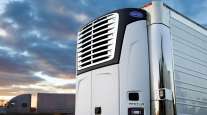Contributing Writer
NFI Motivated to Move Forward on Electric

[Stay on top of transportation news: Get TTNews in your inbox.]
CHINO, Calif. — For-hire carrier NFI is planning broader adoption of electric Class 8 trucks after six months of testing the Freightliner eCascadia in Southern California, the company said.
“We will probably be 30% to 40% electric by 2025. We will be 100% electric at some time in the future,” Bill Bleim, NFI’s senior vice president of fleet services, told Transport Topics during an invitation-only event to discuss its progress with the trucks. “We see it as the future.”
The carrier’s plan has broader significance for the industry, said Bill Van Amburg, executive vice president of Calstart, a Pasadena, Calif., nonprofit clean transportation industry consortium.
The company’s push into electric trucking “will serve as a huge indicator and validator to everyone else in the industry,” he said. “Others will see they cannot afford to get left behind and give NFI that extra edge.”
NFI generates more than $2 billion in annual revenue. It operates approximately 50 million square feet of warehouse and distribution space and has a drayage fleet of more than 4,000 tractors. The company is about to launch a similar program with Volvo Trucks, deploying VNR Electric regional-haul tractors.

The NFI logo on an eCascadia. (Daimler Trucks North America)
The Camden, N.J.-based company took delivery of its first Class 8 eCascadia in August; it now has nine in operation and soon will receive its 10th. But these aren’t production models — the trucks are part of Freightliner’s Electric Innovation Fleet, which Daimler Trucks North America built to test the integration of battery-electric trucks in large-scale fleet operations. NFI is using them to haul containers on 100-175 mile round trips daily between the ports of Long Beach and Los Angeles complex and distribution centers in the Inland Empire region.
This day-to-day testing is providing valuable information for how the trucks handle real-world conditions, and technical changes that might be needed when full-scale production begins late next year, said Andreas Juretzka, DTNA’s head of electrification engineering.
Daimler’s goal for the production model is a Class 8 drayage and regional hauler with 730 peak horsepower and a range of 250 miles. Its target is to have a 550-kilowatt-hour battery that can be recharged to 80% capacity in 90 minutes.
For now, NFI has 150-kW chargers at its distribution center here — where TT was provided a demonstration of the trucks — but faster 350-kW chargers are under development within the industry.
The testing of the eCascadia has revealed a number of surprises, NFI executives told TT.
“It just blows diesel out of the water,” said Jim O’Leary, NFI’s vice president of assets, noting that power and acceleration are dramatically better than comparable diesels. “I also don’t think we were really prepared for the drivers loving them as much as they do,” he said.
One of those drivers, Karl Williams, said the power delivery inherent in the electric powertrain has helped him save time, noting that his afternoon commute hauling containers from the port complex to the Inland Empire takes about 15 minutes less.
“With a diesel when you take off you have all those cars cut in front because you lag back because of the shifting,” he said. The eCascadia keeps him from “falling farther and farther behind,” he said.
In part two of a two-part exploration of autonomous technology today, our latest RoadSigns podcast revisits conversations with Chuck Price of TuSimple and Ognen Stojanovski of Pronto.ai. Hear them discuss a palatable Level 2 version of trucking autonomy. Listen to a snippet above, and to hear the full episode, go to RoadSigns.TTNews.com.
Williams said he has learned to drive the eCascadia using mainly the accelerator pedal and buttons on the steering column that vary the degree of regenerative braking, or energy recapture.
Still, challenges remain. Bleim said while the range is adequate for port runs, NFI is seeing swings based on weather — cold weather reduces range — and traffic. Range is lower when traffic is light since the truck must overcome more aerodynamic drag, using energy more quickly. In stop-and-go traffic it fights less wind and recovers energy from the constant braking
Infrastructure is another challenge. NFI spent about $1 million on its charging stations, engineering and construction — the cost of roughly eight diesel tractors. The installation required nearly a year of conversations and permitting with the city and Southern California Edison, the utility, O’Leary said.
“It’s time-consuming,” Bleim said.
NFI is about to launch an expansion targeted for completion by the end of next year to power more than 50 electric trucks. The company received $500,000 in support for the first chargers, and expects to get more as it builds out infrastructure.
NFI ranks No. 19 on the Transport Topics Top 100 list of the largest for-hire carriers in North America.
The project is part of a partnership supported by Daimler and the South Coast Air Quality Management District to improve air quality in Southern California. It includes 10 more eCascadias and 10 of the smaller medium-duty Freightliner eM2 that Penske Truck Leasing is deploying.
State incentives are the key for building out infrastructure and getting the first trucks in service. The cost would be too great compared to continuing to operate diesel vehicles, O’Leary said.
“Without the incentives, this is tough sell,” he said.
But “it’s exciting to be part of something that’s revolutionary in an industry that is basically built on diesel. We are sitting on the leading edge of something that will change this industry,” O’Leary said.
Want more news? Listen to today's daily briefing:





